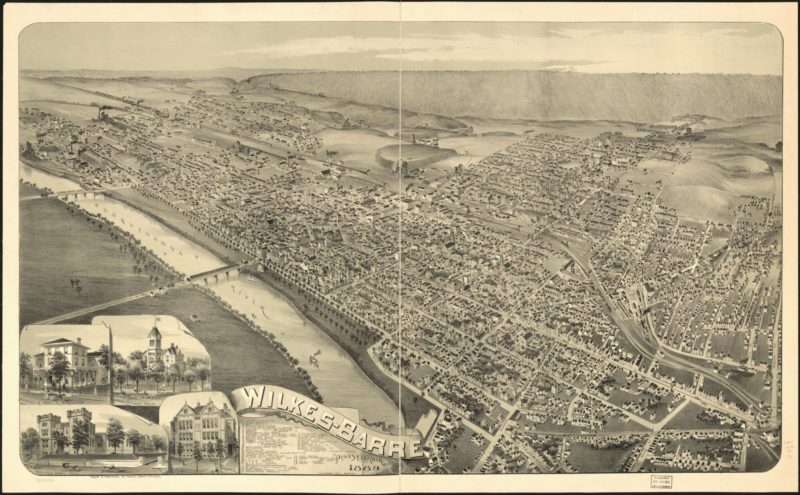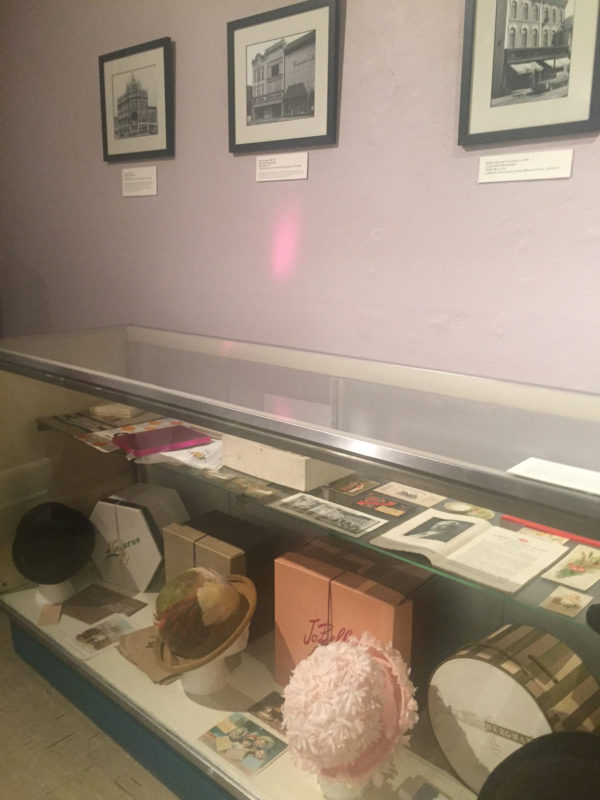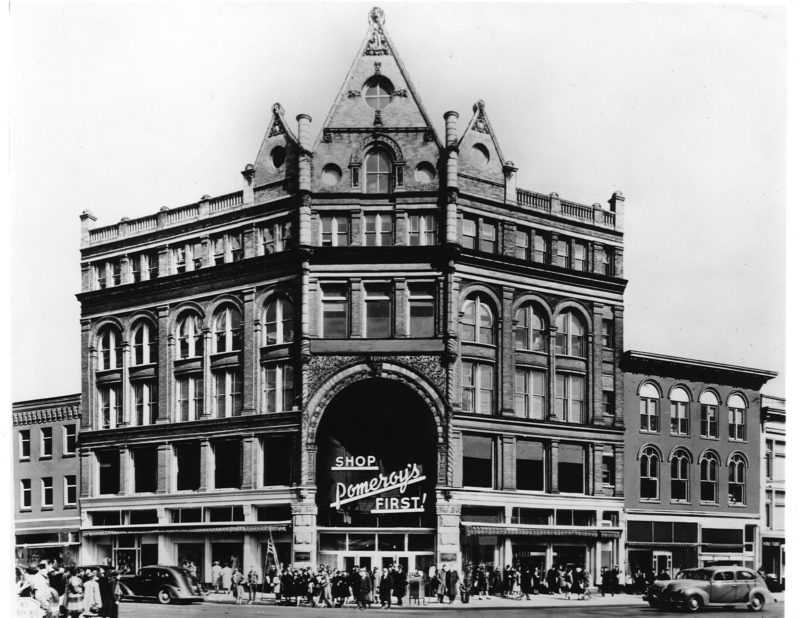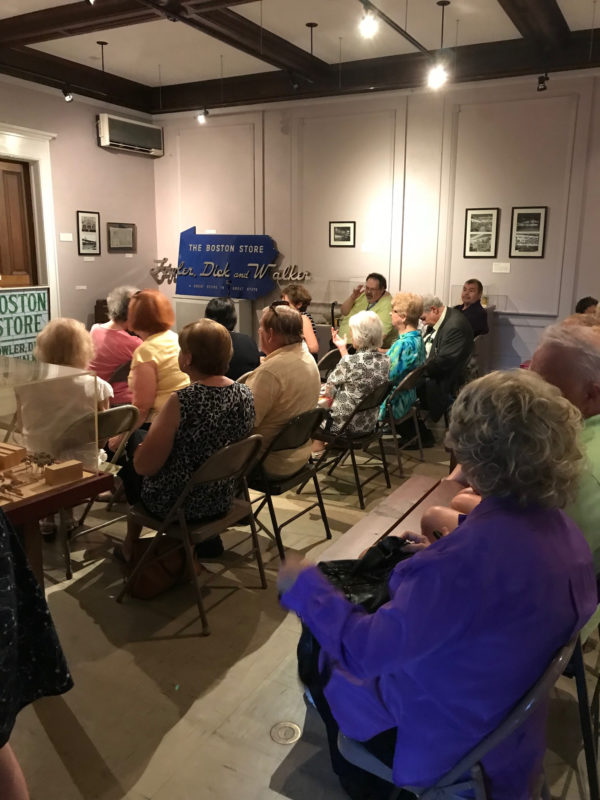Let’s Go Shopping: Stories of Yesteryear Q&A
25 April 2019 – Aimee E. Newell
historical societies, suburbanization, oral history, programming, urban history, exhibitions, consumption, AASLH, small museums

A birds-eye view of Wilkes-Barre, Pennsylvania in the 1880s, when coal made the city an industrial center. Image credit: Library of Congress
Editor’s Note: Our digital media editor Nicole Belolan primarily grew up in rural Pennsylvania, about a 45-minute drive from Wilkes-Barre. As a child, she remembers going frequently to the Wilkes-Barre mall since shopping was limited in her smaller community. When she read about the programming and exhibition at the Luzerne County Historical Society about Wilkes-Barre’s history as a shopping destination, she wanted to learn more. Even though she is too young to have enjoyed Wilkes-Barre’s late nineteenth- and early-mid-twentieth-century downtown shopping, her mother talked about taking special trips there as a child with her mother in the 1950s. In this Q&A with Luzerne County Historical Society executive director Aimee Newell, Nicole learned more about that history and why it still matters to people today.
Nicole Belolan: Can you tell us a little bit about the significance and history of the Luzerne County Historical Society, its collections, and the focus of its public programming?
Aimee Newell: The Luzerne County Historical Society was founded in 1858, making it the oldest county historical society in Pennsylvania. Its mission is to preserve and promote the history and heritage of Luzerne County. Today, the society includes a library and museum in Wilkes-Barre, the 1803 Swetland Homestead in Wyoming, and the 1790 Denison House in Forty Fort. The society has a collection of more than 200,000 objects, documents, and published works ranging from pre-historic Native American items to Revolutionary War-era letters and papers to artifacts from the anthracite coal mining industry of the nineteenth and twentieth centuries. The society continues to actively collect and has been adding items that date into the present.
Our collection inspires many of our programs, as well as our exhibits. During the past two years, we have offered more than twenty-five programs each year, ranging from lectures and gallery talks to walking tours and genealogy workshops. As a local history institution, we aim to reach as much of our community as possible, although, like many history museums, we are working hard to broaden our audience. We try to offer programs that vary in subject to cover the long and fascinating history of Luzerne County.
NB: Where did you get the idea to do an exhibition about shopping?
AN: I came on as executive director in November 2016 and am not from Luzerne County, or even Pennsylvania. I always listen with interest to the personal historical stories that people tell when they are at our events and at society meetings. We have an incredible photo collection and each year we take some favorites to hang in our booth at the local Fine Arts Fiesta event. I was fascinated by how many times people would stop by the photos of shops and stores of the past and excitedly tell each other their memories of shopping there or browsing here.
Wilkes-Barre used to have numerous department stores and shops downtown—it was an early location for Woolworth’s when local resident Fred Kirby (1861-1940) partnered with Charles Sumner Woolworth (1856-1947) in 1884 and pioneered the “five and ten cent store” model. Once someone starts talking about one store, the conversation goes on and on, with the other person bringing up more and more stores. Eventually, I realized that this could be a great idea for an exhibition. I mentioned it to our special events committee in fall 2018 and they loved it so much that they wanted to extend the theme to our annual gala in April 2018, which we did. And, of course, as soon as I mentioned the exhibit at the meeting, the committee members spent about twenty minutes trading stories about their favorite shops of the past, while I furiously took notes. Their excitement about the topic and their enjoyment of sharing those memories really inspired me for the exhibit.
NB: What types of collections did you feature in the exhibition? Are any of the stores represented by those artifacts or photographs still open?

Exhibit case from the “Let’s Go Shopping!” exhibition, fall 2018. Photo credit: Luzerne County Historical Society
AN: We have a small staff and a very small budget, so our exhibitions draw from our own collection. As I mentioned, we have a very large collection, so it offers a lot of inspiration and possibilities. For the shopping exhibition, we included photos, store packaging, shop ledgers from the 1800s, signs and a cash register from the Boston Store, which became Fowler, Dick & Walker (and now Boscov’s is on the same spot in downtown Wilkes-Barre). We included a number of items that had labeling from Luzerne County stores—you can see the hat boxes, each from a different store, in the photo of one of our cases in the exhibition. We also included some garments that had labels sewn in from various local stores, including a dress and a fur coat from the 1950s or 1960s with labels from Fowler, Dick & Walker.

Pomeroy’s Department Store, circa 1940, in Wilkes-Barre, Pennsylvania. Photo credit: Luzerne County Historical Society, L94.10.100.
Boscov’s, as I mentioned, is the only department store left in downtown Wilkes-Barre, but is the successor to the Boston Store and Fowler, Dick & Walker. The other stores that we featured are all closed now. One of my favorite items in the exhibition is the photo of Pomeroy’s department store from about 1940. The Wilkes-Barre store opened in 1927 and closed in 1987, but the building still stands on Public Square today and houses the Wilkes-Barre Chamber of Commerce and other businesses. And, you can still see the “Woolworth” name in the sidewalk in front of the building that used to house that store—but now that spot is home to the downtown Barnes & Noble.
NB: We tend to think that downtown shopping shifted to the suburbs with the rise of the mall. What shifts do we see in Wilkes-Barre or the Wyoming Valley more broadly?
AN: In Luzerne County, the devastating flood in June 1972 after Hurricane Agnes really accelerated the shift to shopping at the mall. The seeds had been planted before the flood—stores in the new Wyoming Valley Mall had opened in 1971 and were starting to attract business—but the flood devastated the primary shopping area of Public Square in Wilkes-Barre, as well as Kingston Corners across the river from Wilkes-Barre, and other areas of the Wyoming Valley. I’ve been told that downtown was shut down for months. Many residents moved to higher ground on either side of the Susquehanna River and it became more convenient to shop at the mall. In addition, the mall was open after the flood when downtown was not. It is at a higher elevation and is not prone to flooding from the river.
NB: What role did shopping establishments play in the lives of people who lived in the region during the time period you cover? Why did they matter?
AN: Shops and stores here developed much in the same way that they did across the country. We focused on the 1940s to 1970s in the exhibition because that was the strength of our collection, but, as I noted, we did include ledgers from some of the early 1800s stores. During the 1760s and 1770s, the area was part of the frontier, so there were few stores and they did not have the variety of goods available in cities like Philadelphia. By the early 1800s, Wilkes-Barre was growing and began to have a larger variety of stores, and those stores began to be more specialized.
By the late 1800s and early 1900s, anthracite coal mining was the primary industry here and many people could afford luxury goods. The sheer number of customers grew through an influx of immigrants and native-born Americans coming to the area to find work in the mines. Not surprisingly, this period overlaps with the rise of the department store—here, as well as across America. I’ve heard many stories from long-time residents about their memories of taking the bus down to Public Square in Wilkes-Barre to go shopping with their parents, grandparents or friends, at the department stores and smaller boutiques. Once automobiles started to become more widespread, people could move further away from the downtown area and there became a market for stores in the city suburbs, which eventually evolved to include the rise of the mall.
NB: How and why did you decide to host a community conversation about stores and shopping in the region? Was that event a success? How did you collect people’s stories that night? What surprised you about what you learned from attendees’ reminisces? How will you be using the memories you collected in the future?
AN: The idea for a community conversation came from reading about similar events at other museums and historical societies, combined with hearing the enthusiasm that people in Luzerne County have for talking about and sharing their history. We did a couple of community conversations in conjunction with a previous exhibition about the Hurricane Agnes flood, with success. And, with all of the stories I kept hearing from people as we started to promote the shopping exhibition, I knew that it would be a great program again. We did two in connection with the shopping exhibition and both were attended by many people who had great stories to share.

A “Lets’ Go Shopping!” community conversation, August 2018. Photo credit: Luzerne County Historical Society.
It was really wonderful to sit and listen to these personal memories that help fill in the human detail of the historical record of photos, newspaper advertisements, and store packaging. We definitely learned things that would be hard to find through traditional research sources. And, with so few people writing letters anymore, we need to be creative about how to collect and preserve stories like the ones we hear at the community conversations. At both events, we digitally recorded the speakers. We have a copy of the recording on DVD in our library and archives and we have also uploaded them to our Vimeo account. We have made the Vimeo version accessible online and we will have the DVD version accessible at our library for any patron who wants to watch it and learn more. By having it available online, we can continue to save it and have it as a resource for researchers of the future.
NB: Thanks for sharing this project with the public history community, Aimee! I’ll make a point of checking out the down Boscov’s and the Historical Society the next time I’m visiting my family.
~Aimee E. Newell, Ph.D., is the executive director of the Luzerne County Historical Society in Wilkes-Barre, Pennsylvania. She also serves on the steering committee of AASLH’s Small Museums Affinity Group.




I don’t know if it came up in any ones comments, but I feel the beginning of the downtown area, began after the mines flooded. I remember that before the flood and when the mines where going.full blast, the stress would stay open until late on Thursday night’s that the miners got paid and the downtown would be packed with shoppers, it was a very vibrant community. Alicia Quackenbush
I don’t know if it came up in any ones comments, but I feel the beginning of the demise of the
downtown area, began after the mines flooded. I remember that before the flood and when the mines where going.full blast, the strores would stay open until late on Thursday night’s that the miners got paid and the downtown would be packed with shoppers, it was a very vibrant community. Alicia Quackenbush